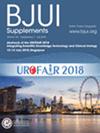Spatial distribution and subtype‐specific expression patterns of Nectin‐4 in muscle‐invasive bladder cancer
IF 3.7
2区 医学
Q1 UROLOGY & NEPHROLOGY
引用次数: 0
Abstract
ObjectiveTo investigate the expression patterns of Nectin‐4, the target molecule of the antibody‐drug conjugate enfortumab vedotin (EV), in relation to histological and molecular subtypes of urothelial bladder cancer (UBC).Patients and MethodsWe assessed the protein expression patterns of Nectin‐4 in a spatially organised tissue microarray containing 1386 tissue cores from 314 consecutive patients with UBC who underwent radical cystectomy (2005–2018). Results were correlated with clinicopathological and follow‐up data, as well as with different spatial locations (tumour central vs tumour‐normal interface and primary tumour vs lymph node [LN] metastases). Additionally, we correlated Nectin‐4 expression levels with histological and molecular subtypes. Finally, we assessed the value of Nectin‐4 expression for predicting the efficacy of platinum therapy in the peri‐operative setting.ResultsNectin‐4 expression was observed in 63% of primary tumours and 87% of LN metastases, with significantly higher levels in LNs. Of the histological subtypes, the micropapillary (58%) and pure urothelial histologies (30%) were associated with the highest Nectin‐4 positivity, while the sarcomatoid (17%), squamous (15%) and small/cell‐neuroendocrine (0%) subtypes exhibited the lowest. Nectin‐4 immunopositivity rates were significantly higher in luminal (urothelial‐like [42%] and genomically unstable [34%] Lund subtypes) compared to the basal (5%) or mesenchymal (0%) molecular subtypes. Higher Nectin‐4 expression levels were associated with lower tumour stage but showed no association with overall survival. Finally, patients with low Nectin‐4 expression tended to derive more benefit from platinum‐based chemotherapy in both adjuvant and neoadjuvant settings (肌浸润性膀胱癌中Nectin - 4的空间分布和亚型特异性表达模式
目的探讨抗体-药物偶联物(EV)靶分子Nectin - 4的表达模式与尿路上皮性膀胱癌(UBC)组织学和分子亚型的关系。患者和方法我们在空间组织组织微阵列中评估了Nectin‐4的蛋白表达模式,该微阵列包含来自314例连续接受根治性膀胱切除术的UBC患者的1386个组织核心(2005-2018)。结果与临床病理和随访数据以及不同的空间位置(肿瘤中心与肿瘤正常界面、原发性肿瘤与淋巴结转移)相关。此外,我们将Nectin‐4的表达水平与组织学和分子亚型相关联。最后,我们评估了Nectin - 4表达对围手术期铂治疗疗效的预测价值。结果在63%的原发肿瘤和87%的淋巴结转移中观察到nectin‐4的表达,在淋巴结转移中表达水平显著升高。在组织学亚型中,微乳头状(58%)和纯尿路上皮(30%)与最高的Nectin - 4阳性相关,而肉瘤样(17%)、鳞状(15%)和小/细胞-神经内分泌(0%)亚型表现最低。与基础(5%)或间充质(0%)分子亚型相比,管腔(尿路上皮样[42%]和基因组不稳定[34%]Lund亚型)的Nectin - 4免疫阳性率明显更高。较高的Nectin - 4表达水平与较低的肿瘤分期相关,但与总生存期无关。最后,低Nectin - 4表达的患者倾向于在辅助和新辅助环境下从铂基化疗中获得更多益处(P <;0.001, p = 0.067)。结论:我们的研究结果显示,在原发肿瘤中,Nectin - 4的表达具有较低的空间异质性。相反,在组织学和分子亚型的背景下发现了差异的Nectin‐4表达。表达Nectin - 4的肿瘤可能对EV和铂基化疗表现出不同的敏感性。
本文章由计算机程序翻译,如有差异,请以英文原文为准。
求助全文
约1分钟内获得全文
求助全文
来源期刊

BJU International
医学-泌尿学与肾脏学
CiteScore
9.10
自引率
4.40%
发文量
262
审稿时长
1 months
期刊介绍:
BJUI is one of the most highly respected medical journals in the world, with a truly international range of published papers and appeal. Every issue gives invaluable practical information in the form of original articles, reviews, comments, surgical education articles, and translational science articles in the field of urology. BJUI employs topical sections, and is in full colour, making it easier to browse or search for something specific.
 求助内容:
求助内容: 应助结果提醒方式:
应助结果提醒方式:


